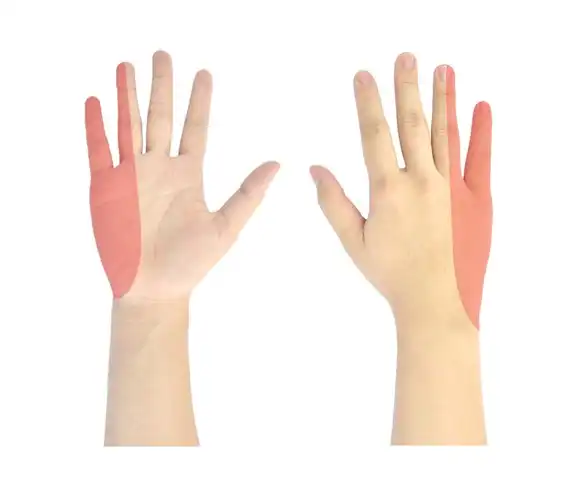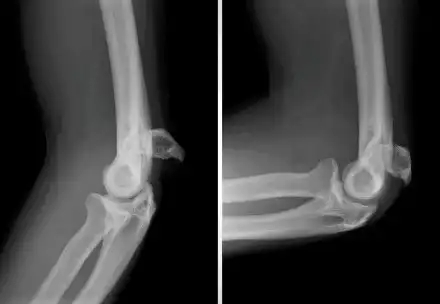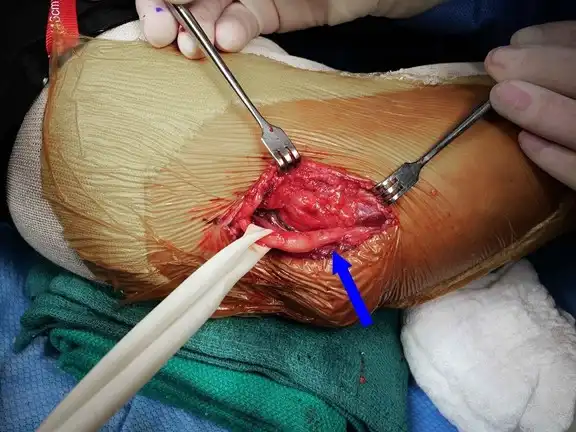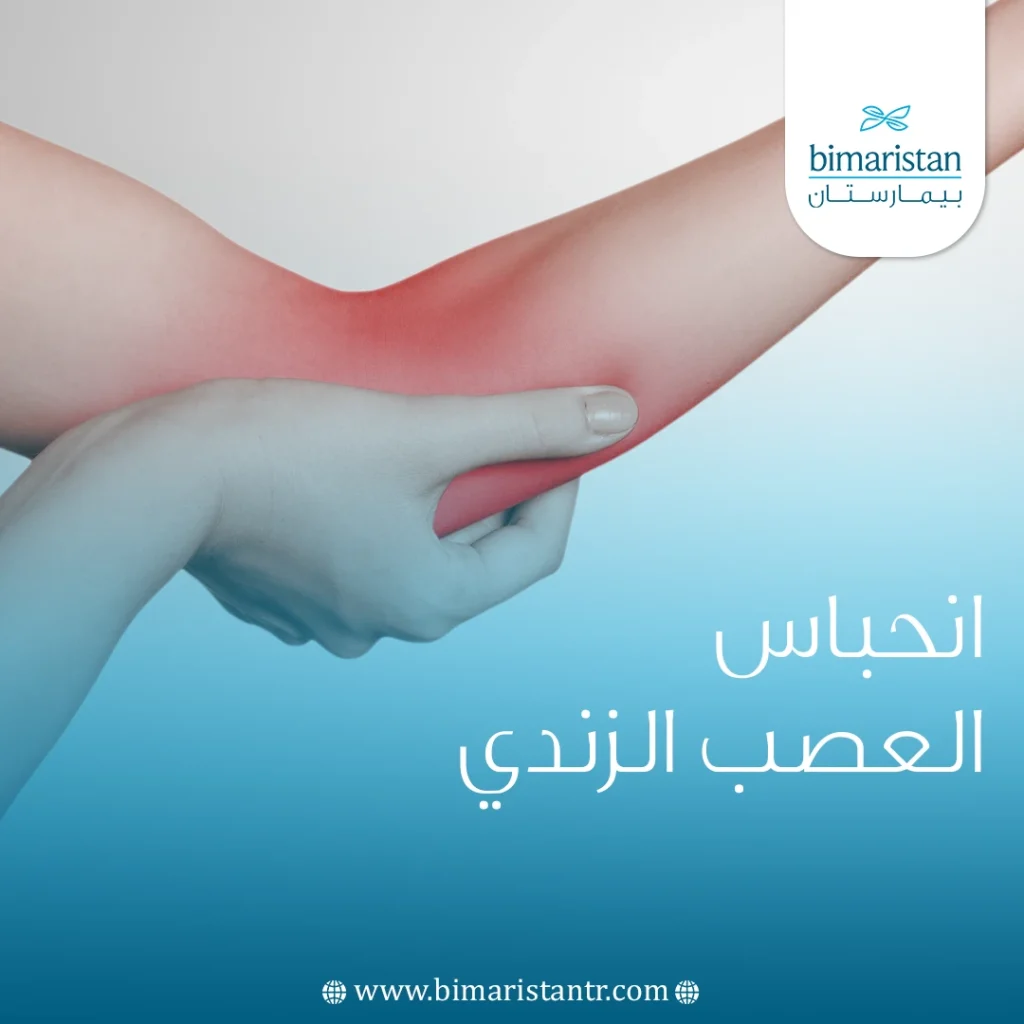طرق علاج انحباس العصب الزندي أو مايعرف بـ متلازمة النفق المرفقي في تركيا عبر أحدث الطرق الجراحية بطاقم طبي من أطباء الجراحة العظمية المتميزين جداً في هذا النوع من العمليات
ما هي متلازمة النفق المرفقي Ulnar nerve entrapment syndrome ؟
متلازمة النفق المرفقي/ انحباس العصب الزندي هي اضطراب عصبي محيطي يتم فيه ضغط العصب الزندي. تسمى هذه الحالة أيضاً بانحباس العصب الزندي عند مفصل المرفق (وليس الكوع).
يمتد العصب الزندي، من الرقبة إلى الأصابع عبر أنبوب أو نفق. عندما يتم ضغطه، لا يحصل على ما يكفي من تدفق الدم ليعمل بشكل صحيح.
مع مرور الوقت، يتسبب الضغط في تلف الأعصاب مما يؤدي إلى الشعور بألم وتنميل في الساعد أو اليد.
تشريح الأعصاب
تنشأ جميع الأعصاب في الأطراف العلوية من الرقبة ثم تتشكل الضفيرة العضدية، عندما تسير الأعصاب نحو اليدين تتفرع إلى 3 أعصاب رئيسية:
- العصب الكعبري
- العصب المتوسط الذي يصاب بمتلازمة النفق الرسغي
- العصب الزندي
ينتقل العصب الزندي على طول الجانب الداخلي من الذراع وصولاً إلى اليد، ويعصب حركيا عضلات الساعد واليد مما يمكن من ثني الأصابع.
كما أنه يعصب حسياً الجلد على الأسطح الأمامية والخلفية للكف والأصابع الصغيرة للسماح بالإحساس.
من يصاب بـ انحباس العصب الزندي؟
يعد انحباس العصب الزندي/ متلازمة النفق المرفقي ثاني أكثر اضطرابات انضغاط العصب المحيطي شيوعاً بعد متلازمة النفق الرسغي. ومع ذلك، فهو نادر نسبياً؛ كل عام، يشخص الأطباء أقل من 25 حالة لكل 100 ألف شخص.
تتطور متلازمة النفق المرفقي عند الأشخاص من جميع الأعمار. ويصاب الرجال ضعف عدد النساء، على الرغم من أن الباحثين لا يعرفون السبب.
قد تكون أكثر عرضة للخطر إذا:
- كنت تعمل في وظيفة تتطلب حركات معصم متكررة.
- أبقيت مرفقك في حالة الانعطاف لفترات طويلة (على سبيل المثال، أثناء التحدث في الهاتف).
- تعرضت لصدمة، مثل ضربة، على العصب الزندي.
- كان لديك اختلافات جسدية تزيد من المخاطر، مثل الاختلاف في شكل النفق المرفقي.
- كنت ممن يعانون من السمنة المفرطة أو يعانون من مرض السكري أو التهاب المفاصل الروماتويدي أو أمراض الغدة الدرقية.
- كان عمرك فوق الأربعين عام.
- كان لديك التهاب مفاصل.
ما الذي يسبب متلازمة النفق المرفقي؟
يمكن أن يؤدي الاستمرار في تكرار نفس المهمة لوقت طويل، إلى شد أو ضغط العصب الزندي، كما يمكن أن يؤدي تلف الألياف العصبية أو تراكم السوائل المزمن إلى الضغط على العصب.
أعراض متلازمة النفق المرفقي
يجب الانتباه للأعرض وعدم إهمالها أو تناسيها لأنه إذا تُركت متلازمة النفق المرفقي دون علاج، فيمكن أن تترك تلفاً دائماً في الأعصاب.
تشمل الأعراض:
- خدر أو تنميل أو وخز في يدك وأصابعك
- ألم حارق (يبدو وكأنه قطعة ثلج في ساعدك)
- ضعف في الخنصر وأصابعك
- صعوبة في ضم الإبهام والخنصر معاً
- ألم على طول الجزء الداخلي من المرفق والساعد
- تتهيج الأعراض عند وضع المرفق في وضع منحني لفترة طويلة من الزمن (مثل استخدام الهاتف المحمول، القيادة، النوم) وحركات الرمي المتكررة
- إحساس بالضغط على المرفق من الداخل أثناء ثنيه وتقويمه
- صعوبة في استخدام يدك للتلاعب بالأشياء خاصة في المهام التي تتطلب مستوى عالٍ من مهارة الإصبع (مثل الكتابة أو العزف على آلة موسيقية)
- ضعف اليد وصعوبة الإمساك

يمكن أن يحدث هزال عضلات اليد في الحالات المزمنة طويلة الأمد وهو من المضاعفات.
تشخيص انحباس العصب الزندي في تركيا
في زيارتك الأولى، سيقوم الأطباء بإجراء فحص جسدي شامل ويسألك عن تاريخك الطبي. قد تشمل الاختبارات:
- تخطيط كهربية العضل: يرسل طبيبك تياراً كهربائياً خفيفاً إلى إبرة موضوعة في العضلة حيث يقيس مدى جودة تزويد العصب للإشارات الكهربائية التي تتسبب في تقلص العضلات.
إذا كان العصب لا يعمل بشكل صحيح، فهذا يساعد في تحديد مكان تلف الأعصاب. - اختبار سرعة التوصيل العصبي (دراسة التوصيل العصبي): يحفز طبيبك العصب بنبضة كهربائية ويقيس مدى سرعة تحركه عبر العصب، حيث يمكن أن تشير الإشارات العصبية التي تكون أبطأ إلى نوع الضرر وشدته.
فحص الطبيب
التاريخ الطبي والفحص البدني
سيناقش طبيبك تاريخك الطبي وصحتك العامة. وقد يسأل أيضاً عن عملك وأنشطتك والأدوية التي تتناولها وبعد مناقشة الأعراض والتاريخ الطبي، سيفحص طبيبك ذراعك ويدك لتحديد العصب الذي يتم ضغطه.
تتضمن بعض اختبارات التشخيص الفحص البدني التي قد يقوم بها طبيبك ما يلي:
- الضغط على العصب عند العظم المضحك. إذا كان العصب متهيجاً، فقد يتسبب ذلك في صدمة في الإصبع الصغير والبنصر، على الرغم من أن هذا يمكن أن يحدث عندما يكون العصب طبيعياً أيضاً.
- التحقق مما إذا كان العصب الزندي ينزلق خارج الوضع الطبيعي عند ثني المرفق.
- تحريك رقبتك وكتفك ومرفقك ورسغك لمعرفة ما إذا كانت الأوضاع المختلفة تسبب الأعراض.
- التحقق من الشعور الحسي والقوة في يدك وأصابعك.
الاختبارات والطرق التشخيصية
- توفر اختبارات التصوير بالأشعة السينية صوراً مفصلة للهياكل الكثيفة، مثل العظام. رغم أن معظم أسباب انضغاط العصب الزندي لا يمكن رؤيتها بالأشعة السينية.
ومع ذلك، قد يأخذ طبيبك صوراً بالأشعة السينية لمرفقك أو رسغك للبحث عن النتوءات العظمية أو التهاب المفاصل أو الأماكن الأخرى التي قد يضغط فيها العظم على العصب.

- يمكن أن تحدد اختبارات التوصيل العصبي مدى جودة عمل العصب وتساعد في تحديد مكان ضغطه، نظرا لشبه الأعصاب “بالكابلات الكهربائية” التي تنتقل عبر جسمك وتحمل الرسائل بين دماغك وعضلاتك، فعندما لا يعمل العصب بشكل جيد، يستغرق الأمر وقتاً أطول حتى ينقل السيالة العصبية.
أثناء اختبار التوصيل العصبي، يتم تحفيز العصب في مكان واحد ويتم قياس الوقت الذي يستغرقه حدوث الاستجابة كما سيتم اختبار عدة أماكن على طول العصب ومن المحتمل أن تكون المنطقة التي تستغرق الاستجابة وقتاً طويلاً فيها هي المكان الذي يتم فيه ضغط العصب.
علاج متلازمة انحباس العصب الزندي في تركيا
ما لم يتسبب انضغاط الأعصاب بالكثير من هزال العضلات، فمن المرجح أن يوصي طبيبك أولاً بالعلاج غير الجراحي.
علاج انحباس العصب الزندي بدون جراحة
- الأدوية المضادة للالتهابات: إذا بدأت الأعراض للتو، فقد يوصي طبيبك بأدوية مضادة للالتهابات، مثل إيبوبروفين، للمساعدة في تقليل التورم حول العصب.
- على الرغم من أن الستيرويدات، مثل الكورتيزون، هي أدوية فعالة جداً كمضاد للالتهابات، إلا أن حقن الستيرويد لا يستخدم عموماً بسبب وجود خطر تلف العصب.
- الدعامة أو التجبير: قد يصف طبيبك دعامة أو جبيرة مبطنة لارتدائها ليلاً لإبقاء مرفقك في وضع مستقيم.
- تمارين انزلاق العصب: يعتقد بعض الأطباء أن التمارين التي تساعد العصب الزندي على الانزلاق عبر النفق المرفقي عند المرفق وقناة جويون عند الرسغ يمكن أن تحسن الأعراض. قد تساعد هذه التمارين أيضاً في منع تصلب الذراع والمعصم.
علاج انحباس العصب الزندي الجراحي في تركيا/ اسطنبول
قد يوصي طبيبك بإجراء عملية جراحية لـ علاج انحباس العصب الزندي إذا:
- لم تحسن الطرق غير الجراحية حالتك
- كان العصب الزندي مضغوط للغاية
- تسبب إصابة العصب في ضعف العضلات أو تلفها
هناك عدد قليل من الإجراءات الجراحية التي من شأنها تخفيف الضغط على العصب الزندي عند المرفق، سيتحدث جراح العظام معك عن الخيار الأفضل لك.
غالباً ما تتم هذه الإجراءات في العيادة الخارجية، لكن بعض المرضى يفضلون الإقامة في المستشفى لليلة واحدة.
ومن العلاجات الجراحية المتوفرة في تركيا:
- تحرير النفق المرفقي: في هذه العملية، يتم قطع وتقسيم رباط النفق المرفقي. هذا يزيد من حجم النفق ويقلل الضغط على العصب.
بعد العملية، يبدأ الرباط في التعافي وتنمو أنسجة جديدة عبر الانقسام. مع زيادة طول الرباط حول العصب يتيح ذلك مساحة أكبر للعصب الزندي للانزلاق من خلاله.
يميل إطلاق النفق المرفقي إلى العمل بشكل أفضل عندما يكون ضغط العصب خفيفًا أو معتدلًا ولا ينزلق العصب من خلف الحافة العظمية لللقيمة الإنسيّة عندما يكون المرفق مثنياً.

- تبديل العصب الزندي الأمامي: في كثير من الحالات، يتم نقل العصب من مكانه خلف اللقيمة الإنسية إلى مكان جديد أمامه.
يؤدي تحريك العصب إلى مقدمة اللقيمة الإنسيّة إلى إمكانية التمدد عند ثني مرفقك.
يمكن تحريك العصب ليستلقي تحت الجلد والدهون ولكن فوق العضلة (تبديل تحت الجلد)، أو داخل العضلة (التحويل بين العضل)، أو تحت العضلة (التحويل تحت العضلي).
للتبديل الأمامي للعصب الزندي، يتم إجراء شق على طول الجزء الداخلي من المرفق أو على طول الجانب الخلفي من المرفق.
- علاج العصب المنضغط عن طريق استئصال اللقيمة الإنسية: خيار آخر لتحرير العصب هو إزالة جزء من اللقيمة الإنسية.
مثل تبديل العصب الزندي، تمنع هذه التقنية أيضاً العصب من الوقوع في حافة العظام والتمدد عند ثني مرفقك
فترة التعافي بعد علاج انحباس العصب الزندي جراحياً
اعتماداً على نوع الجراحة التي تخضع لها، قد تحتاج إلى ارتداء جبيرة لبضعة أسابيع بعد العملية، عادةً ما يتطلب التحويل تحت العضلي وقتاً أطول (3 إلى 6 أسابيع) في جبيرة.
قد يوصي الجراح بتمارين العلاج الطبيعي لمساعدتك على استعادة القوة والحركة في ذراعك، سيتحدث معك أيضا عن الوقت الذي سيكون فيه من الآمن العودة إلى جميع أنشطتك العادية.
النتيجة الجراحية
تكون نتائج جراحة علاج انحباس العصب الزندي جيدة بشكل عام. كل طريقة من طرق الجراحة لها معدل نجاح مماثل للحالات الروتينية لضغط العصب.
إذا تم ضغط العصب بشكل سيئ للغاية أو إذا كان هناك هزال أو شلل في العضلات، فقد لا يتمكن العصب من العودة إلى طبيعته وقد تبقى بعض الأعراض حتى بعد الجراحة.
تتعافى الأعصاب ببطء، وقد يستغرق الأمر وقتاً طويلاً لمعرفة مدى جودة عمل العصب بعد الجراحة.
العلاجات المنزلية لعلاج متلازمة اعتلال النفق المرفقي
هناك العديد من الأشياء التي يمكنك القيام بها في المنزل للمساعدة في تخفيف الأعراض و علاج انحباس العصب الزندي، أما إذا كانت أعراضك تتداخل مع الأنشطة العادية أو استمرت لأكثر من بضعة أسابيع، فتأكد من تحديد موعد مع طبيبك.
ومن هذه العلاجات نذكر:
- تجنب الأنشطة التي تتطلب منك إبقاء ذراعك مثنياً لفترات طويلة من الزمن.
- إذا كنت تستخدم جهاز كمبيوتر بشكل متكرر، فتأكد من أن مقعدك ليس منخفضاً جداً، لا تضع مرفقك على مسند الذراع.
- تجنب الاتكاء على مرفقك أو الضغط على ذراعك من الداخل. على سبيل المثال، لا تقود مع وضع ذراعك على النافذة المفتوحة.
- حافظ على استقامة كوعك في الليل عندما تكون نائمًا. يمكن القيام بذلك عن طريق لف منشفة حول مرفقك المستقيم أو ارتداء وسادة المرفق للخلف.
المصادر:








